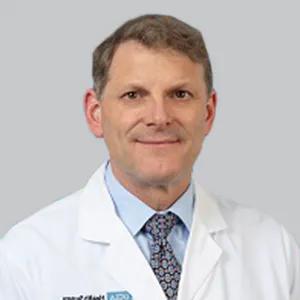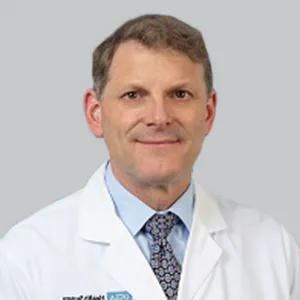Even though Steven Cramer is a superstar stroke researcher he doesn't appear to have any focus on 100% recovery which is what stroke survivors want.
Dr. Steven Cramer (19 posts to October 2011)
Long-Term Function Decline and Rehabilitation Therapy Utilization Poststroke
Steven C. Cremer, MD, (Really, you spelled his name wrong)stroke neurologist and professor of neurology at UCLA, talked about the 3 main types of rehab therapy given to poststroke patients and the significant disparities in access.
Steven C. Cramer, MD

Known as a leading cause for long-term disability, previous research has shown that greater rehabilitation therapy poststroke can improve functional outcomes.1 Therefore, the delivery of effective rehabilitation programs with adequate resources, dose, and duration is a critical aspect of care(Once again with 'care' NOT RESULTS OR RECOVERY!) poststroke, according to guidelines from healthcare professionals affiliated with the American Heart Association/American Stroke Association.2
Recently published in the journal Stroke, a study showed that rehabilitation therapy doses were low during the first year of recovery following stroke and were also predicted by clinical factors.3 In 510 poststroke patients, rehab therapy was mostly low and given in the first 3 months, as 35.0% of patients had no physical therapy, 48.8% received no occupational therapy, and 61.7% had no speech therapy. Also, discharge destination was significantly related to cumulative therapy (for all therapy types at visit 2, P <.05; occupational therapy visits 3 and 4, P <.05; speech therapy visits 3 and 4, P <.01) and across the variety of sites, as 0% to 71% of patients were discharged to an inpatient rehabilitation facility.
Steven C. Cramer, MD, stroke neurologist and professor of neurology at UCLA, sat down in an interview with NeurologyLive® to discuss the 3 main classes of rehab therapy that were discussed in the study. He also shared some of the surprising findings regarding therapy utilization among poststroke patients. Cramer spoke about the implications and potential impact on long-term function and therapy utilization decline over time.
NeurologyLive®: Why did you choose those 3 specific therapies for this research?
Steven C. Kramer, MD:(Really, you spelled his name wrong again) Those are probably the 3 main classes of rehab therapy that people get, for better or for worse. Structurally, that's how it's broken down, and historically, PTs (physical therapists) tend to be more involved with walking and strength. OTs tend to be more involved with arms and function. These are gross generalizations, and speech therapists tend to be involved with language and swallowing. There are other entities such as psychologists, social workers, and nutritionists, but the STRONG study had a limited budget and there's a limited number of questions that we could have.
There were 28 sites around the country [involved in the study], each of which asked patients about their rehab. We went with the 3 most common forms of rehab therapy that people get after stroke. They correspond to 3 very common types of things that go wrong with stroke: walking and strand, arm strength and functional status, and then speech and swallowing.
Was there anything surprising that you found from the results and thought was quite notable?
Up to the first 3 months [poststroke], a third of people never saw any physical therapy and half never saw any occupational therapy. Also, 60% never saw any speech therapy. We thought it was going to be barren and we were surprised it was that barren. Hispanic patients got less therapy, which was also a little bit surprising. It fits with other reports that people of certain ethnicities and socioeconomic strata tend to get less care. Maybe that wasn't totally surprising, but it confirmed it for us. Then, maybe not surprise, but we were pleased that even though some people were getting so little therapy, at least the more severe cases tended to get more doses of therapy, even in the oddly narrow spectrum.
Do you think there should be longer follow up study investigating the 3 types of therapies?
There are 2 answers to that question. The narrower one is: should we follow people for longer to see if they get more rehab therapy as time goes on? This gets medium enthusiasm for it because what we saw and we described is that with each success of 3-month quarter, the amount of new therapy people was getting was smaller and smaller. By 1 year, fewer people got any further rehab therapy. The yield would be modest because therapy tends to stop over a matter of months, and for most people by a year.
This is an offshoot of a larger study that looked at outcomes in relation to genetics and that's not our focus here. We know that after stroke, people have a real big sudden decline in function and things they can do, and that there's some spontaneous recovery. For movement, it tends to plateau around 3 months. For thinking and memory and language, there's a big jump at 3 months and they often continue to improve in little bits for maybe a year or sometimes longer. Somewhere around a year, people started slow decline and the brain doesn't keep up. Age-matched people with stroke showed faster decline after a year than people who did not have a stroke who are showing a decline anyhow. The average age of stroke is 70, and, by that age most people are losing a little bit of function every year without stroke, but it’s even more for patients poststroke.
I think it's important to continue studies, examine how function declines beyond the year poststroke, and look at the genetic correlates of that. Unfortunately, I suspect we have doses given to patients even lower after a year, it's more of the older populations that go to their physician and say, “I want to walk better,” who are mostly people that have resigned to whatever level of function they're left with at that point.
Transcript edited for clarity.

No comments:
Post a Comment